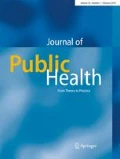Abstract
The protection, promotion and support of breastfeeding are a public health priority throughout Europe. Low rates and early cessation of breastfeeding have important adverse health and social implications for women, children, the community and the environment; they result in greater expenditure on national health care provision and increase inequalities in health. Extensive experience clearly shows that breastfeeding can be protected, promoted and supported only through concerted and coordinated action. The Blueprint for Action, written by breastfeeding experts representing all European Union and associated countries and the relevant stakeholder groups, including mothers, is a model plan that outlines the actions that a national or regional plan should contain and implement. It incorporates specific interventions and sets of interventions for which there is an evidence base of effectiveness. Under six headings—policy and planning; information, education and communication; training; protection, promotion and support; monitoring; research—the Blueprint recommends objectives for all these actions, identifies responsibilities, and indicates possible output and outcome measures. It is hoped that the application of the Blueprint will achieve a Europe-wide improvement in breastfeeding practices and rates (initiation, exclusivity and duration); more parents who are confident, empowered and satisfied with their breastfeeding experience; and health workers with improved skills and greater job satisfaction.

Similar content being viewed by others
Notes
The International Code of Marketing of Breast-milk Substitutes and the subsequent relevant WHA Resolutions are jointly referred to in this article as the International Code.
http://europa.eu.int/comm/health/ph_information/indicators/docs/ev_20040219_rd04_en.pdf
References
Aarts C, Kylberg E, Hornell A, Hofvander Y, Gebre-Medhin M, Greiner T (2000) How exclusive is exclusive breastfeeding? A comparison of data since birth with current status data. Int J Epidemiol 29:1041–1046
American Academy of Pediatrics Work Group on Breastfeeding (1997) Breastfeeding and the use of human milk. Pediatrics 100:1035–1039
Bland RM, Rollins NC, Solarsh G, Van den BJ, Coovadia HM (2003) Maternal recall of exclusive breast feeding duration. Arch Dis Child 88:778–783
Campbell M, Fitzpatrick R, Haines A, Kinmonth AL, Sandercock P, Spiegelhalter D, Tyrer P (2000) Framework for design and evaluation of complex interventions to improve health. BMJ 321:694–696
Des Jarlais DC, Lyles C, Crepaz N (2004) Improving the reporting quality of nonrandomized evaluations of behavioral and public health interventions: the TREND statement. Am J Public Health 94:361–366
EU Council (2000) Resolution 14274/00, Brussels
EU Project on Promotion of Breastfeeding in Europe (2003) Protection, promotion and support of breastfeeding in Europe: current situation. European Commission, Directorate for Public Health and Risk Assessment, Luxembourg
EU Project on Promotion of Breastfeeding in Europe (2004a) Protection, promotion and support of breastfeeding in Europe: a blueprint for action. European Commission, Directorate Public Health and Risk Assessment, Luxembourg
EU Project on Promotion of Breastfeeding in Europe (2004b) Protection, promotion and support of breastfeeding in Europe: review of interventions. European Commission, Directorate for Public Health and Risk Assessment, Luxembourg
European Commission (1991) Directive 91/321/EEC. EEC, Brussels
International Labour Organization (2000) Maternity Protection Convention C183. ILO, Geneva
León-Cava N, Lutter C, Ross J, Martin L (2002) Quantifying the benefits of breastfeeding: a summary of the evidence. Pan American Health Organization, Washington DC
Nutrition and diet for healthy lifestyles in Europe: science and policy implications (2001) Public Health Nutr 4:265–273
Société Française de Santé Publique (2000) Health and human nutrition: elements for European action, Nancy
UNICEF/WHO (1990) Innocenti Declaration, Florence
Victora CG, Habicht JP, Bryce J (2004) Evidence-based public health: moving beyond randomized trials. Am J Public Health 94:400–405
WHO/EURO (2001) The first action plan for food and nutrition policy. WHO European Region 2000–2005. WHO Regional Office for Europe, Copenhagen
WHO/UNICEF (1989) Protecting, promoting and supporting breastfeeding: the special role of maternity services. WHO, Geneva
World Health Assembly (1981) International Code of Marketing of Breastmilk Substitutes. WHO, Geneva
World Health Organization (1991) Indicators for assessing breastfeeding practices. WHO, Geneva
World Health Organization (2003) Global Strategy for Infant and Young Child Feeding. WHO, Geneva
World Health Organization,Unicef (1993) Indicators for assessing health facility practices that affect breastfeeding. WHO, Geneva
Yngve A, Kylberg E, Sjostrom M (2001) Breast-feeding in Europe—rationale and prevalence, challenges and possibilities for promotion. Public Health Nutr 4:1353–1355
Acknowledgements
The Blueprint for Action was written by the Project Coordinator, Adriano Cattaneo, and his team at the Unit for Health Services Research and International Health, IRCCS Burlo Garofolo, Trieste, Italy: Anna Macaluso, Simona Di Mario, Luca Ronfani, Paola Materassi, Sofia Quintero Romero, Mariarosa Milinco and Alexandra Knowles. They wrote on behalf of the members of the project Steering Committee: Christine Carson (United Kingdom), Flore Diers-Ollivier and Nathalie Roques (France), Berthold Koletzko and Hildegard Przyrembel (Germany), Luis Ruiz Guzman (Spain), Michael Sjöström and Agneta Yngve (Sweden); and of all project participants: Ilse Bichler and Anne-Marie Kern (Austria), Françoise Moyersoen (Belgium), Tine Jerris and Ingrid Nilsson (Denmark), Kaija Hasunen (Finland), Vicky Benetou and Themis Zachou (Greece), Geir Gunnlaugsson, Ingibjörg Baldursdóttir and Jona Margret Jonsdottir (Iceland), Genevieve Becker and Maureen Fallon (Ireland), Maryse Lehners-Arendt (Luxembourg), Adrienne de Reede (The Netherlands), Anne Baerug (Norway), Isabel Loureiro (Portugal), Jenny Warren, Susan Sky and Janet Calvert (United Kingdom), Kim Fleischer Michaelsen (International Society for Research in Human Milk and Lactation), Andrew Radford (UNICEF UK Baby Friendly Initiative), Aileen Robertson (WHO Regional Office for Europe), Lida Lhotska (IBFAN/GIFA). The Promotion of Breastfeeding in Europe project was funded by the European Commission, Directorate Public Health and Risk Assessment (EU Project Contract no. SPC 2002359).
Author information
Authors and Affiliations
Corresponding author
Additional information
On behalf of the Promotion of Breastfeeding in Europe project participants
Rights and permissions
About this article
Cite this article
Cattaneo, A. Breastfeeding in Europe: a blueprint for action. J Public Health 13, 89–96 (2005). https://doi.org/10.1007/s10389-004-0089-3
Received:
Accepted:
Published:
Issue Date:
DOI: https://doi.org/10.1007/s10389-004-0089-3



